Media release
From: James Cook UniversityYellow crazy ants are a disaster for some of Australia’s unique skink species – with new James Cook University research revealing the invasive ants are killing the reptiles.
JCU’s Associate Professor Lori Lach is an expert on the behaviour of the aggressive, rapidly spreading invasive species.
“Invasive ants outcompete or prey on native ants and other insects, often leading to population declines or local extinctions. But effects on vertebrates, such as skinks, are less studied,” said Dr Lach.
Yellow crazy ants are best known for their killing of millions of red land crabs and ensuing cascade of ecological impacts on Christmas Island.
Numerous jurisdictions in Queensland, the Northern Territory and New South Wales are attempting to control or eradicate the ants to avoid the associated environmental and socioeconomic impacts.
Dr Lach said a complicating factor is that baits used to kill yellow crazy ants can also harm other species, and this too, is not very well-studied.
The research team investigated the effect of baits and yellow crazy ants on skinks in four different types of environments – baited areas with high and low abundance of yellow crazy ants, baited areas without yellow crazy ants, and control areas without baiting or yellow crazy ants.
The team worked with the Wet Tropics Management Authority and their Yellow Crazy Ant Eradication Program staff to select suitable sites for the study.
“We recorded a virtual absence of small skink species in areas where yellow crazy ants had been in high abundance,” said Dr Conrad Hoskin, a leading researcher in reptile diversity and conservation, and a co-author of the study.
Over 600 skinks were observed during the study. Sites that had low yellow crazy ant activity or that had been baited but did not have yellow crazy ants had similar numbers of skinks as the control sites that had never had yellow crazy ants or baiting.
While the study found impacts of abundant yellow crazy ants on small skinks, a co-occurring larger skink species appeared to be unaffected by the ants.
“Our data suggest that yellow crazy ants, but not the bait used to treat them, pose a direct threat to small rainforest skinks,” said Dr Lach.
She said the results raise concern over the impact of yellow crazy ants on lizards and other small vertebrates where the ants have invaded and are not being managed, globally, and for the Wet Tropics, should eradication fail.
“We just don’t know how far these biodiversity impacts extend. Our findings are an indication that these ants will likely have wider impacts should they spread,” said Dr Hoskin.
The study has been published in the journal Biodiversity and Conservation and is available at https://rdcu.be/cEJM8


